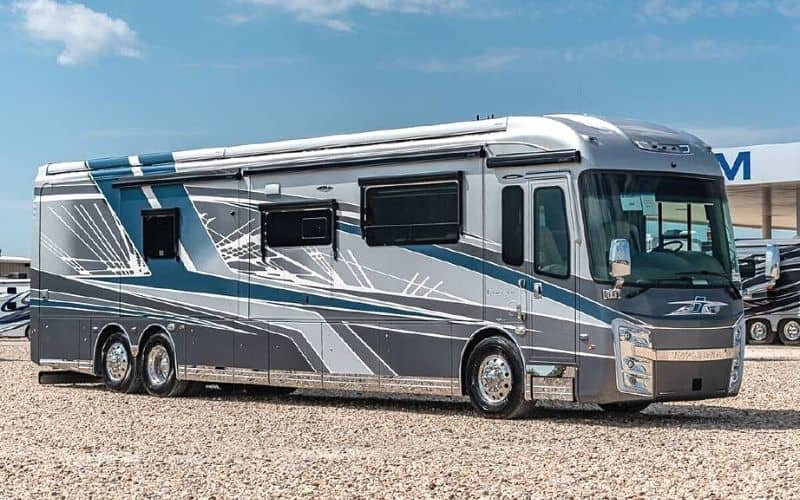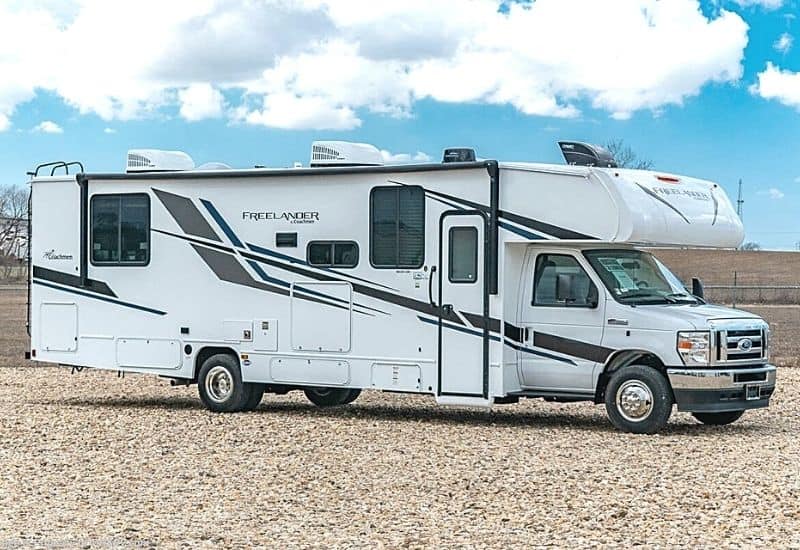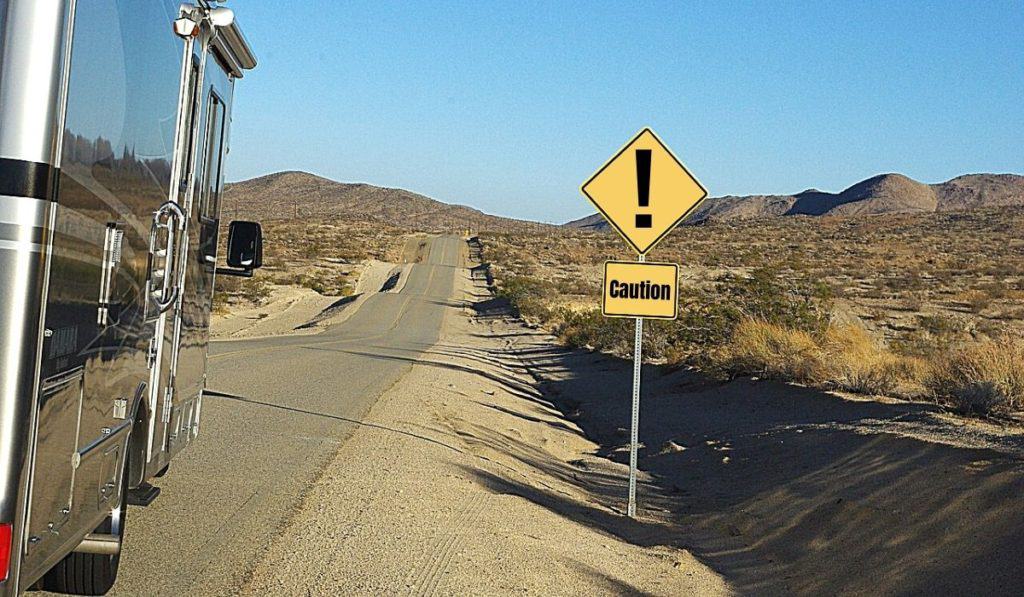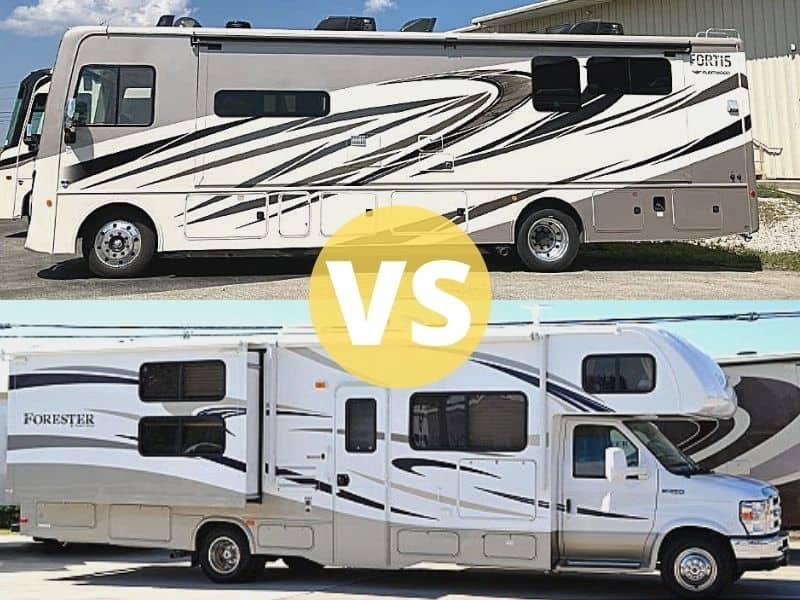Class A and Class C RVs share many similarities since they’re both self-contained motorhomes.
However, these two RV Classes also have many differences as well, with one of the main differences being their overall size.
As Class A RVs in general are much larger compared to Class C RVs, with Class A RVs ranging in length from 30 feet to 45 feet and Class C RVs ranging in length from 25 feet to 32 feet.
If you’re looking for a more detailed answer on Class A and Class C RV lengths though, make sure to keep reading.
As we provide lengths for some of the most popular Class A and Class C RVs on the market, as well as lengths on the five longest Class A and Class C RVs you can buy.
Popular Class A RVs Lengths (Shortest to Longest)
- Winnebago Vista 31B – 31 Feet 2 Inches
- Jayco Alante 29F – 32 Feet 2 Inches
- Winnebago Adventurer 35F – 35 Feet 5 Inches
- Forest River FR3 34DS – 35 Feet 11 Inches
- Coachmen Mirada 35ES – 36 Feet 10 Inches
- Foretravel Realm FS450 LSSB – 37 Feet 8 Inches
- Forest River Georgetown GT7 36D7 – 37 Feet 11 Inches
- Entegra Reatta XL 39BH – 39 Feet 11 Inches
- Tiffin Phaeton 40QKH – 41 Feet 4 Inches
- Newmar Dutch Star 4369 – 43 Feet 9 Inches
Popular Class C RVs Lengths (Shortest to Longest)
- Thor Motor Coach Four Winds 24F – 25 Feet 1 Inch
- Tiffin Wayfarer 25LW – 25 Feet 8 Inches
- Gulf Stream Conquest 6250 – 26 Feet 9 Inches
- Forest River Sunseeker 2550DSLE – 29 Feet 4 Inches
- Coachmen Freelander 27QB – 29 Feet 6 Inches
- Nexus Triumph 30T – 31 Feet 7 Inches
- Forest River Forester 3051S – 31 Feet 11 Inches
- East to West Entrada 2900DS – 32 Feet 3 Inches
- Jayco Redhawk 31F – 32 Feet 6 Inches
- Winnebago Minnie Winnie 31H – 32 Feet 9 Inches
5 Largest Class A RVs on the Market

Now that we’ve established that Class A RVs are generally larger than Class C RVs, let’s take a look at just how much larger they can be.
By highlighting the five largest Class A RVs you can buy.
- Entegra Cornerstone 45B – 45 Feet 5 Inches
- Tiffin Allegro Bus 45 OPP – 45 Feet
- Foretravel Realm Presidential Series FS605 LVMS – 45 Feet
- Emerald Prevost H3-45 – 45 Feet
- Newell Coach p50 – 45 Feet
To see more information on the five largest Class A RVs, check out our article “The 5 Longest Class A Motorhomes You Can Buy“.
5 Largest Class C RVs on the Market

Just because Class A RVs are generally bigger than Class C RVs, that doesn’t mean that there aren’t some really big Class C RVs out there.
As the largest Class C RVs are over 30 feet in length.
Making large Class C RVs as long or longer than some Class A RVs, especially cheaper and smaller Class A RVs.
- Coachmen Freelander 31MB – 32 Feet 11 Inches
- Gulf Stream 6320 – 32 Feet 11 Inches
- Winnebago Minnie Winnie 31K – 32 Feet 9 Inches
- Nexus Triumph 32T – 32 Feet 9 Inches
- Winnebago Spirit 31K – 32 Feet 9 Inches
To see more information on the five largest Class C RVs, check out our article “The 5 Longest Class C Motorhomes You Can Buy“.
Other Differences Between Class A and Class C RVs
Size isn’t the only difference between Class A and Class C RVs though, as these two different RVs Classes have many other differences as well.
So to help those that are trying to decide between a Class A or Class C RV, we thought we’d spend the rest of this article discussing the other main differences between the two RV Classes.
Chassis Type
Starting from the ground up, the first major difference between Class A and Class C RVs, beyond their overall size, is the type of chassis that they’re built on.
Because while Class C RVs are built on cutaway passenger van chassis, such as the Ford E-Series or the Chevrolet chassis, Class A RVs are built on larger and more sturdy bus chassis, such as the Ford F-53 or the Freightliner XC.
Exterior Design
One of the easiest ways to tell Class A and Class C motorhomes apart is from their exterior design.
As Class A RVs are wider, taller, and heavier and offer a more streamlined look, thanks to their single structure design that flows uninterrupted from the front of the coach to the rear.
While Class C RVs are narrower, shorter, and lighter and have a more boxy look, thanks to their two distinct and separate sections, comprised of a front cab area and rear cutaway body, as well as their cab-over design.
As almost all Class C RVs have a cab-over design, which means that the living area extends over the front cab of the RV to provide additional sleeping or space storage.
Miles Per Gallon
- Class A RV Fuel Economy – 6 to 10 Miles Per Gallon
- Class C RV Fuel Economy – 8 to 12 Miles Per Gallon
Another difference between Class A and Class C RVs is their average miles per gallon.
Because while neither motorhome is going to win any awards for MPGs, there is a difference between the two RV Classes.
As Class C RVs typically get slightly better gas mileage compared to Class A RVs.
However, keep in mind that many factors can affect RV gas mileage, including the size and weight of the camper as well as whether the RV is equipped with a gas or diesel engine.
As diesel engines tend to be more fuel-efficient compared to gas engines.
For more information on the differences between gas and diesel RV engines, check out our article “Which RV Gets Better Gas Mileage: Gas vs Diesel?“.
RV Safety

When discussing RV safety there are two main considerations to be concerned with, which include how safe the RV is while traveling and how safe the RV is while camping, as they both can have a big impact on you and your family’s safety.
So which is safer Class A or Class C RVs?
Both RV Classes tend to receive pretty equal marks when it comes to safety while camping, as most major RV manufacturers, whether they make Class A RVs, Class C RVs, or both, are members of the RVIA, which requires them to agree to unannounced inspections and adhere to over 500 different safety and construction standards including electrical, plumbing, heating, propane, and fire safety.
However, when it comes to RV travel and crash safety, there is a difference between the two, with Class C RVs receiving slightly higher marks.
Because while both RV Classes perform well in minor crashes, Class C RVs tend to provide more protection in major crashes.
To see why this is and to learn more about RV safety, check out our article “How Safe are RVs: Things You Need to Know“.
Tire Size
While you might assume that an RV tire is an RV tire and that both Class A and Class C RVs would use pretty much the same size and type of tire, this is not the case.
As Class A RVs typically use a much larger tire size compared to Class C RVs, which helps to improve the ride comfort, shock absorption, and handling of a Class A motorhome.
- Most Common Class A RV Rim Sizes – 19.5 Inches, 22.5 Inches, 24.5 Inches
- Most Common Class C RV Rim Sizes – 16 Inches, 19.5 Inches
Engine Type
Gasoline and diesel are the two main types of engines found in motorhomes.
And while Class A RVs offer a mix of gas and diesel engine options.
With smaller and less expensive Class A RVs using gasoline engines and larger and more expensive Class A RVs using diesel engines.
Class C RVs use gasoline engines almost exclusively, unless you move up to a Super C, as these larger Class C motorhomes tend to utilize a diesel engine.
Engine Configuration
The final factor that separates Class A and Class C RVs is their engine configuration.
As Class C RVs exclusively have a front-engine configuration, while Class A RVs can have either a front-engine or rear-engine configuration, depending on whether it has a gas or diesel engine.
As Class A RVs with gas engines use a front-engine design, while Class A RVs with diesel engines use a rear-engine design.
To see what it’s like to drive a Class A RV, check out our article “Is It Hard to Drive a Class A RV? What You Need to Know“.
Recent Posts
47 RV Storage Ideas to Maximize Your Space for Compact Living
Camping and living in an RV is an incredible adventure, but it comes with its fair share of challenges, particularly around storage, due to the lack of space. Because of this, it's a must to make...
Are you looking to give your RV a cozy, rustic makeover? If so, farmhouse RV decor is the perfect style to transform your camper into a warm and inviting home on wheels. In this blog post, I'll...

